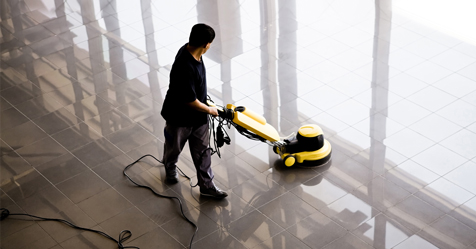If you look at where we are today compared to where we began, you’ll likely agree that we are light years away from the first attempts to maintain flooring in commercial buildings.
Initially, variety was limited; flooring choices for common areas were basically stone, wood or linoleum.
All were natural materials, and each had characteristics that could cause maintenance headaches.
If left unprotected from the scarring effects of foot traffic, the floors would show signs of premature wear and would often need replacement far sooner than anticipated.
Even with the advent of vinyl flooring options, the need for sacrificial protective coatings to delay or eliminate the damage from dirt, grit and other soils was apparent.
Early protective coatings consisted of natural waxes and polishes, which were difficult to maintain and proved problematic when a complete strip was necessary.
Some of these early products could actually penetrate the pores of the floors and needed to be manually sanded and scrapped off.
Can you imagine the time-consuming difficulty and the associated costs of such a labor-intensive process?
Almost all hard surface flooring — including ceramic tiles, terrazzo, quarry tile and, in some cases, natural stone — was treated just like vinyl composition tile (VCT) and finish was applied.
Back in the Stone Age — no pun intended — most hard floor care operations consisted of routine services like sweeping, mopping and buffing.
When those operations were no longer effective, the floor was stripped of its finish — what once was, and is still commonly, called wax — and recoated, which was considered a restorative process.
A majority of maintenance programs were basically cleaning processes designed to prolong the time between stripping and refinishing cycles.
There was some consideration as to the useful life of the flooring, but early maintenance programs were designed to control the costs of refinishing, which were quite expensive.
Sacrificing Appearance To Cut Costs
Further intensifying the maintenance headache, early floor finishes had to be matched to the type of equipment available to a contractor or in-house professional.
Low-speed finishes — which, by the nature of their formulation, were extremely durable and difficult to abrade — were just not as glossy as the high-speed, thermally-activated finishes that could be burnished to build or repair gloss.
With constraints such as floor machines operating at a mere 175 revolutions per minute (RPM), janitors, custodians, maintenance technicians and other cleaning personnel were not able to cross high-gloss finishes with low-speed equipment.
Smaller buildings and facilities with tight corridors or congested areas could not have floors with the “wet look” that gained popularity in the 1980s because the equipment needed to properly burnish the finish was simply too large to maneuver.
Also, smaller locations like branch offices or independent medical facilities would often fail to maintain their floors in a timely manner, stretching necessary servicing as far as possible to save money.
High-gloss, thermally-activated finishes were often more malleable than their low-speed counterparts, allowing them to be stimulated by the friction of a burnisher to soften the top layer, which helps repair minor blemishes and restores gloss.
I won’t even get started on ceramic tiles being coated with finishes: Complete removal was always difficult from the grout channel, if the contractor or in-house custodian could get the finish to bond to the ceramic in the first place.
It was much easier to maintain terrazzo but, due to inexperience, many terrazzo floors were “sealed” with a concrete sealer, creating a surface film that made it difficult for a finish to bond.
It was wholly misunderstood just how these pore-clogging sealers accomplished their protection, and many were washed off by using cleaning agents that were too strong for routine cleaning purposes, especially in foodservice areas.
Restaurant kitchen floors covered with quarry tile caused many levels of concern because of the inherent porosity of the tile coupled with a lighter color grout and the necessity of a non-slip surface.
Stone floors were challenging and, because their natural tendencies were mysterious and unknown, many viewed their maintenance as downright scary.
There was limited information on natural stone products, and the guidance that was available only addressed stone soap and restoration abrasion techniques for marble; there was virtually no information on granite, travertine or slate.
Let’s just say that cleaning and maintaining hard surface floors “back in the day” was difficult, cumbersome and absolutely not for the novice.
Floor Care Reaches Maturity
Fast forward to today and you will see that the picture of modern floor care is painted very differently than that of the past.
The Internet has provided a wealth of information to the flooring professional, along with a plethora of trade magazines that relay manufacturer information to a thirsty group of maintenance professionals.
Trade organizations like ISSA, the Building Service Contractors Association International (BSCAI) and the Institute for Inspection, Cleaning and Restoration Certification (IICRC) have been invaluable in aggregating content to reach consensus on how we should be caring for the same old flooring.
Most flooring professionals today are no longer applying finish to ceramic tiles, so their grout lines are not being protected from the abuse of foot traffic.
Since grout is a low spot of concrete between the tiles, routine sweeping and mopping is only good for pushing a variety of soils into the valleys.
Thankfully, we now have turbo-type cleaning tools that combine a high-pressure spray with chemical agitation to remove the buildup of soils that have accumulated therein.
There are also any number of detergents specifically formulated with a combination of ingredients designed to emulsify protein soils found in grout, along with safer acid products — non-hydrofluoric or muriatic varieties — to remove non-organic soils also found in grout channels.
To avoid unintended damage, only neutral detergents with safe, mild ingredients — read: No chelating agents designed to dissolve hard water minerals — should be used on mineral-based grout or stone surfaces.
Reduced Chemistry Floor Maintenance
VCT no longer has to be wet stripped; in fact, stripping can be performed without using any chemical at all.
The previous sentence should be read again by anyone who has ever traditionally wet stripped a finished floor, as this is a truly amazing feat.
There are oscillating floor machines that, through a completely dry process, can remove almost all of the finish from a floor.
The maturation of hard floor care is eliminating many of the headaches of yore: No more sloppy slurry, no wet machine cords, no step-off issues and no more incomplete removal of finish leading to discoloration issues.
The stripping pads currently available offer more complete removal — they are effective even when used dry — of today’s more complex and much sturdier floor finishes.
You might be wondering, “What does dry or chemical-free stripping offer me and my colleagues?”
Since there is no chemical to soften or “unlock” the polymers creating the film, there is also no need to remove the slurry mixture of spent stripping solution with wet vacuuming equipment.
Dry stripping a floor also allows you to bypass rinsing or neutralization in many cases, reducing labor and equipment costs.
With specific regard to the square-shaped machines available, removing finish near walls or in corners proves much easier.
A chemical-free process also means that cross-contamination issues — stepping in slurry and then tracking footprints into other areas not designated to be stripped — are no longer a concern.
It is far easier to control a machine that oscillates randomly than it is to tame a swing buffer with rotary action, simplifying cut-ins and other movements.
Moreover — this should ring true to any industry veterans who have seen their fair share of new hires come and go — think about how many walls, baseboards and tile dividers can be saved if rookie employees weren’t faced with learning how to maneuver a rotary floor machine.
Revisiting The Stone Age
Some of the greatest developments of this century have been related to the maintenance of stone flooring.
The old way was to just use diamond disks to resurface the stone after it was abraded, scratched or etched by foot traffic.
The height between different tiles, what is commonly called “lippage,” had to be flattened before re-polishing services could begin.
To counter this, many steps had to be employed with increasingly finer grit pads being used — as a result of the necessary preparation and restoration tasks, quite a mess developed before the stone exhibited any type of reflective shine.
Today, we have a lot of choices to restore shine to stone flooring.
Abrasive powders are commonly selected, some of which will crystalize with the addition of an acidic product to create great shine.
However, one must be careful about the long-term use of an acidic product on calcium-based stone like marble, limestone or travertine because a thick layer of crystalizing compound can build up after routine use and cause damage to the stone.
Using an old school trick and pairing it with new age technology, diamond-impregnated polyester floor pads, which are far more flexible than traditional disks, can add a great shine to softer stone surfaces.
These pads will float over tile lippage just like powders used in disk applications, but they don’t make anywhere near the mess because the abrasive is not loose, but sprayed onto the pad to create an abrasive surface that lightly cuts into the surface of the stone.
These pads come in many grit configurations and are sized to fit not only floor machines, but also smaller equipment like hand tools to restore shine on vertical surfaces or in hard-to-reach-areas.
Another area that has critically changed since commercial floor care became and enterprise are the types of penetrating sealers available.
Recent additions to the penetrating sealer product category, including fluoropolymer products similar to those used in carpet protectors, offer protection against stains from all types of liquids, greases and other non-water-based spills.
Today’s high-tech and professionally-engineered sealers mean the outdated and incredibly impractical technique of just filling the pores of a floor surface with olive oil — which, as one can imagine, caused all kinds of problems — are a thing of the past.
All things considered, today’s equipment, product choices, wealth of information and the ability for contractors to be certified by any number of professional organizations makes this a much better time to be involved with the industry.
Although it sure was interesting discovering, experiencing and surmounting the multitude of potential problems “back in the day,” we survived long enough to teach a new generation how to properly clean and maintain their hard surface floors.
Good luck to you all, and remember to thank the old folks who have been there and done that in order to make the once-future dreams of floor care a current reality.



